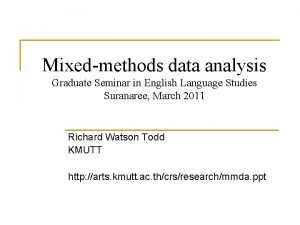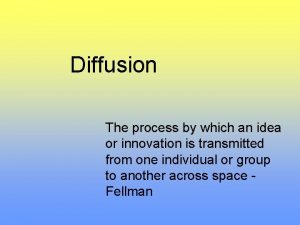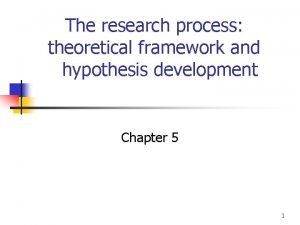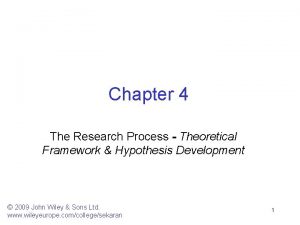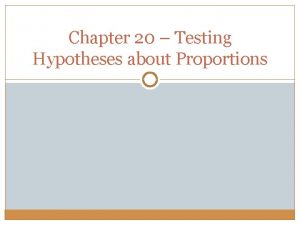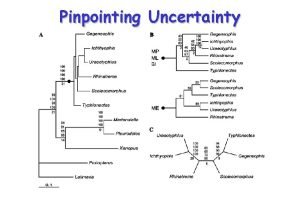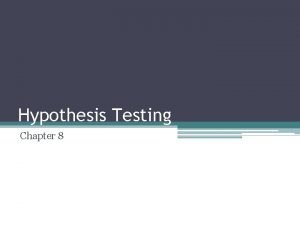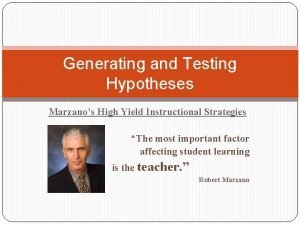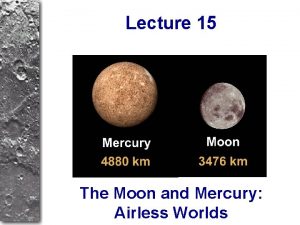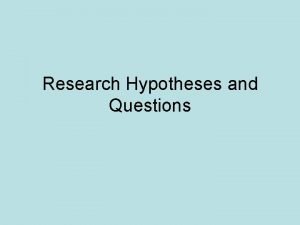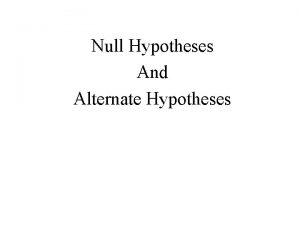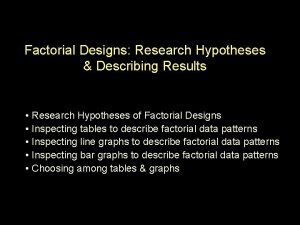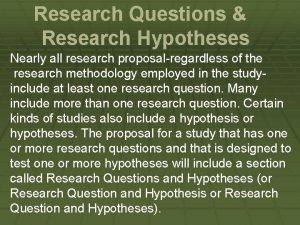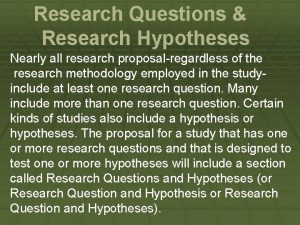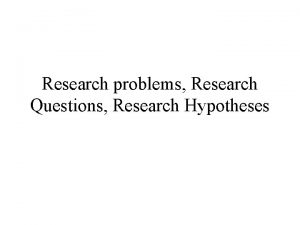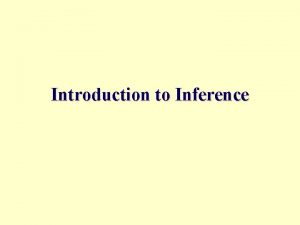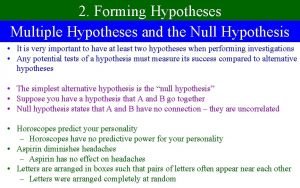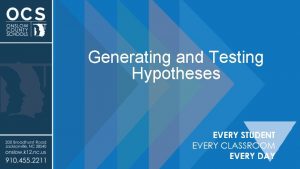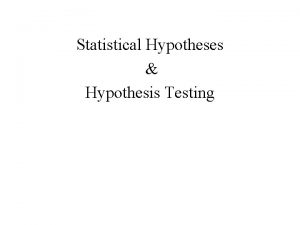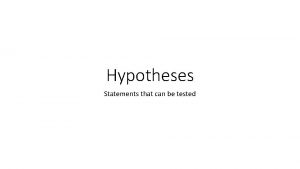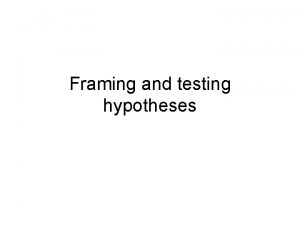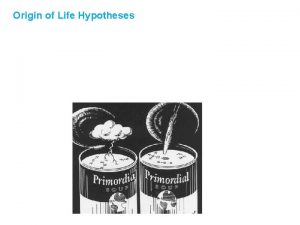RESEARCH QUESTIONS HYPOTHESES THE PROCESS OF INTRODUCING A














- Slides: 14

RESEARCH QUESTIONS & HYPOTHESES

THE PROCESS OF INTRODUCING A PROBLEM Stimulate reader interest in the problem Demonstrate the importance of the problem Provide current status of the problem Introduce any relevant theory examined in the study Place the study within the context of literature Identify the population to study

INTRODUCTORY SECTION ORGANIZATION Global perspective Diabetes is a devastating and costly disease • Morbidity • Mortality • Financial cost More Specific Successful and unsuccessful attempts to intervene Most Specific The purpose of this study is to examine new ways to educate people with diabetes

PURPOSE STATEMENT How you frame and state the research problem is critical to the entire research project…it is the foundation for the remainder of your work. Clearly express the problem as a purpose statement and/or research question(s) to be answered Clearly state a hypothesis (if appropriate)

FORM FOR THE PROBLEM STATEMENT The problem statement can be written as either a question or as a declarative statement Research questions are interrogative sentences They may be used following a general statement of purpose to identify sub-problems that will be answered Research questions are generally used in lieu of hypotheses and indicate the use of non-experimental study designs

RESEARCH QUESTIONS CAN BE USED ALONG WITH A GENERAL STATEMENT OF PURPOSE TO IDENTIFY SUBPROBLEMS THAT WILL BE ANSWERED The purpose of this study was to determine the characteristics of students who use the Health and Wellness Center five or more times per week. What is the gender profile of students who use the HWC five or more times per week? What is the racial/ethnic profile of students who use the HWC five or more times per week? What is the BMI of students who use the HWC five or more times per week? What is the attitude toward wellness of those students who use the HWC five or more times per week?

VARIABLES Dependent Variable– the variable that is measured or observed…outcome variable Ask “What is dependent upon what? ” Independent Variable – variable being examined or tested Control Variable – variable whose potential to impact the dependent variable has been removed or “controlled for” by the study design or statistical manipulation

WHAT IS A HYPOTHESIS? Expresses the relationship between two or more variables States the predicted outcome of a test A hypothesis can be tested (proved or disproved)

DIRECTIONAL AND NONDIRECTIONAL HYPOTHESES Nondirectional hypotheses: predict a difference between groups, but do not specify what the difference might be Null hypothesis (Ho ): statement of no difference The means or scores are not different Alternative hypothesis (Ha ): statement of difference The means or scores are different in a predicted direction

EXAMPLES Nondirectional: There will be a difference in contraceptive knowledge level of students that participated in an abstinence-only sexuality education program and the contraceptive knowledge level of students who participated in an abstinence-based sexuality education program. Null Hypothesis: There will be no difference in the contraceptive knowledge level of students that participated in an abstinence-only sexuality education program and the contraceptive knowledge level of students who participated in an abstinence-based sexuality education program. Alternative Hypothesis: The contraceptive knowledge levels of students that participated in an abstinence-only sexuality education program will be lower than the contraceptive knowledge level of students who participated in an abstinence-based sexuality education program.

HYPOTHESIS TESTING Is the difference in contraceptive knowledge levels between the two groups of students large enough to convince us that it is the result of the differences between the two types of education programs and not simply chance or normal variation. Most often test the null hypothesis (there is no difference between the contraceptive knowledge levels of the two groups) Use statistical tests to determine the probability that the null hypothesis is true

HYPOTHESIS TESTING Type I Error Rejecting a true H 0 Type II Error Failure to reject a false H 0 Note: a H 0 is never “accepted” p-values Standard is 5%

TIMELINES Most research proposals include a fairly detailed anticipated schedule for the planned research project. 1. Create a list of all the steps from planning the study through the dissemination of results 2. Create a calendar that shows when each of these steps is expected to begin and end 3. Set deadlines along the way that will help ensure that the project stays on track toward timely completion

PART I: ARTICLE ANALYSIS Problem or purpose? Hypotheses ? Nondirectional, null, or alternative Dependent variable Independent variable(s) Part II: Your research question & timeline
 Mixed methods research examples
Mixed methods research examples Example of hypothesis testing
Example of hypothesis testing Hypothesis example in research
Hypothesis example in research Stimulus diffusion definition
Stimulus diffusion definition Theoretical framework independent dependent variable
Theoretical framework independent dependent variable Framework hypothesis
Framework hypothesis Chapter 20 testing hypotheses about proportions
Chapter 20 testing hypotheses about proportions Theoretical framework and hypothesis development
Theoretical framework and hypothesis development Ruling out rival hypotheses
Ruling out rival hypotheses Analysis of competing hypotheses template
Analysis of competing hypotheses template Two types of hypotheses
Two types of hypotheses General to specific ordering of hypothesis
General to specific ordering of hypothesis Chapter 19 testing hypotheses about proportions
Chapter 19 testing hypotheses about proportions Marzano high yield strategies
Marzano high yield strategies Hypotheses
Hypotheses
